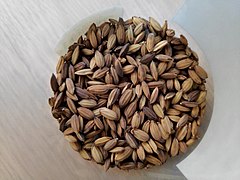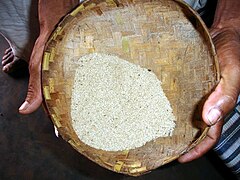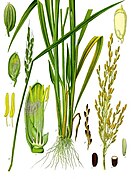Oryza sativa
| Oryza sativa | |
|---|---|

| |
| Mature seed heads | |

| |
| Inflorescence | |
| Scientific classification | |
| Kingdom: | Plantae |
| Clade: | Tracheophytes |
| Clade: | Angiosperms |
| Clade: | Monocots |
| Clade: | Commelinids |
| Order: | Poales |
| Family: | Poaceae |
| Genus: | Oryza |
| Species: | O. sativa
|
| Binomial name | |
| Oryza sativa | |
| Synonyms[1] | |
|
List
| |
Oryza sativa, also known as rice, is the plant species most commonly referred to in English as
Oryza sativa belongs to the genus
Botany
The species has an erect and stout or slender stalk stem that grows 80–120 cm (30–45 in) tall, with a smooth surface. The leaf is lanceolate, 15–30 cm (5+7⁄8–11+3⁄4 in) long, and grows from a ligule 10–20 mm (3⁄8–3⁄4 in) long.[7]
Classification
Oryza sativa contains two major subspecies: the sticky, short-grained
A third subspecies, which is broad-grained and thrives under tropical conditions, was identified based on morphology and initially called javanica, but is now known as tropical japonica. Examples of this variety include the medium-grain 'Tinawon' and 'Unoy' cultivars, which are grown in the high-elevation rice
Glaszmann (1987) used isozymes to sort O. sativa into six groups: japonica, aromatic, indica, aus, rayada, and ashina.[12]
Garris et al. (2004) used
Nomenclature and taxonomy
Rice has been cultivated since ancient times and oryza[14] is a classical Latin word for rice while sativa[15] means "cultivated".
Genetics
SPL14/LOC4345998 is a gene that regulates the overall
Rice is one of the earliest uses and validation models for the semi-thermal asymmetric reverse PCR (STARP) method developed in 2016.[17]
Resistance to the rice blast fungus
O. sativa has a large number of
In total, 641
The plant hormones abscisic acid and salicylic acid are employed by O. sativa for regulation of immune responses.[22] Salicylic acid broadly stimulate and abscisic acid suppresses immunity to the rice blast fungus M. grisea, and success depends on the balance between their levels.[22]
Breeding
The
The complete genome of rice was sequenced in 2005, making it the first crop plant to reach this status.
Since then, the genomes of hundreds of types of rice, both wild and cultivated, and including both Asian and African rice species, have been sequenced.A triple
Gallery
-
Water buffalo ploughing, Java
-
Jumli Marshi, brown rice from Nepal
-
Traditional rice ofNiyamgiri Hills, India
-
From Chhattisgarh
-
Stem cross section magnified 400 times
See also
- Black rice
- Domesticated plants and animals of Austronesia
- International Code of Nomenclature for Cultivated Plants
- Japonica rice
- Maratelli rice
- O. glaberrima (African rice)
- Traceability of genetically modified organisms
References
- ^ "Oryza sativa L." Plants of the World Online. Board of Trustees of the Royal Botanic Gardens, Kew. 2017. Retrieved December 21, 2020.
- S2CID 140691699.
- .
- ISBN 978-1-85728-538-3.
- PMID 23284907.
- ISSN 1369-5266.
- ^ Catindig, J.L.A.; Lubigan, R.T.; Johnson, D. (n.d.). "Oryza sativa". Rice Knowledge Bank. International Rice Research Institute. Retrieved June 29, 2023.
- ^ S2CID 205216444.
- ^ Oka (1988)
- S2CID 92050510.
- ^ CECAP, PhilRice and IIRR. 2000. "Highland Rice Production in the Philippine Cordillera."
- S2CID 22829122.
- PMID 15654106.
- ^ "oryza". Merriam-Webster.com Dictionary.
- ^
- "sativa". Lexico UK English Dictionary. Oxford University Press. n.d.
- "sativa". Merriam-Webster.com Dictionary.
- ).
- ^ S2CID 33780984. Chinese Academy of Sciences+Chinese Society for Plant Biology+Shanghai Institutes for Biological Sciences.
- S2CID 8922855.
- PMID 24442397.
- ^ OCLC 1110184027.
- ^ S2CID 247603925.
- ^ a b
- Pieterse, Corné M.J.; Van der Does, Dieuwertje; Zamioudis, Christos; Leon-Reyes, Antonio; Van Wees, Saskia C.M. (November 10, 2012). "Hormonal Modulation of Plant Immunity". S2CID 9244874.
- Pieterse, Corné M.J.; Van der Does, Dieuwertje; Zamioudis, Christos; Leon-Reyes, Antonio; Van Wees, Saskia C.M. (November 10, 2012). "Hormonal Modulation of Plant Immunity".
- ^
Li, Wei; Deng, Yiwen; Ning, Yuese; He, Zuhua; Wang, Guo-Liang (2020). "Exploiting Broad-Spectrum Disease Resistance in Crops: From Molecular Dissection to Breeding". S2CID 214600762.






